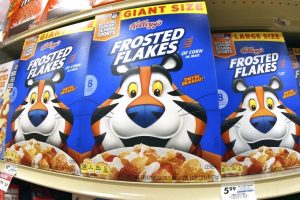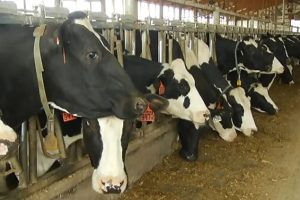
HUDSON, Iowa (DTN) — Sleeping in is often a luxury on a dairy farm. Even for 12-year-olds, which Reese Hansen knows all too well.
On a recent February morning, it wasn’t Reese’s turn to get up at 6 a.m. to feed and water calves on her family’s farm near Hudson, Iowa. Her brother or cousin had that honor in below-freezing temperatures. Understandably, the pre-teen looked forward to getting an extra hour of sleep, cuddled up in her warm bed, before getting ready for school.
Rooster, though, had other plans. No, we’re not talking about a cock-a-doodle-dooing chicken welcoming a new day. Rooster is an 11-month-old joey and apparently wanted cuddles, too.
Kangaroos and cows keep life hopping at Hansen’s Dairy.
“It was 5:45 a.m.,” Reese exclaimed. “Rooster got out of his pouch (he sleeps in a fleece-lined bag hanging on a door handle in the house, which simulates his mother’s pouch) and was hopping around the house and squawking because he was scared and alone. So, I got up to save him.
“I cuddled with him on the couch. Then I got (8-month-old) Roobarb (another joey) and we all watched TV together before going to school,” she continued. “Sometimes the babies can be annoying, like getting up early or eating things they’re not supposed to. But I love them.”
Blake and Jordan Hansen, along with their daughter, Reese, and nine-year-old son, Beckett, love every minute when baby kangaroos are in the house. Even late-night diaper runs (litter training doesn’t work), before pre-dawn bottle feedings and, at times, the sleep deprivation that comes with it.
After all, Rooster and Roobarb are an integral part of the dairy farm’s marketing and agritourism efforts. The farm’s 300 Holsteins produce the milk, but it’s the family’s seven kangaroos that help sell it, in addition to 22 flavors of ice cream, butter, cheese curds and other products made on the farm.
Rooster and Roobarb, along with Larry, Rocket, Rookie, Roodolph and Rooby are the farm’s mascots. A kangaroo drinking milk is part of the dairy’s logo. The marsupials are also a big reason why nearly 10,000 people pay up to $15 each to tour the farm each year to interact with the kangaroos and cows and learn about dairy production and processing. Raising the joeys for a few months in the house helps tame and assimilate the animals to people.
Cows are cool, Blake Hansen said, but he knows the kangaroos are the star attraction of the dairy, which is by design.
“The kangaroos not only help with sales but attract tourists to the farm. People get to see how their milk and ice cream is made and how we care for and love our cows,” he added, noting each cow has a name, such as Eva or Massive, which is written on her ear tag. “Cows and kangaroos are kind of unique to see together in Iowa.”
BUILDING A BRAND
Hansen’s Dairy — operated by brothers Brent, Brad, Blair and Blake Hansen and their families — is the only dairy in the state and probably the nation with kangaroos, according to Jordan Hansen, the farm’s marketing manager. Jay and Jeanne Hansen, the brothers’ parents, are mostly retired but still help out occasionally.
Each of the Hansen brothers has a specific role on the farm:
— Brent is the delivery manager. He keeps the family’s dairy outlet stores in nearby Waterloo and Cedar Falls stocked and delivers dairy products to other retailers and customers.
— Brad is the creamery manager. He’s in charge of processing milk and making dairy products.
— Blair is the crops manager, supplying feed for the animals. He’s also the farm’s Mr. Fix-It.
— Blake is herd and milking manager. He and his family also care for the kangaroos.
EXPANSION PLANS
In the early 2000s, Blake and Blair — the youngest brothers — were working on the farm full-time with their parents. Brent and Brad wanted to join the operation. Since there wasn’t enough space and land to expand the herd to 1,000 head, which was the estimate to support five families selling bulk milk, the Hansens decided to invest about $500,000 to build a creamery and sell dairy products directly to consumers. With more than 100,000 potential patrons within a 25-mile radius of the farm, feasibility studies indicated the dairy could earn enough money to support all the families.
Hansen’s Dairy has been wildly successful since it started selling dairy products 18 years ago. The family estimated they would have to process and sell half the milk — on average, about 150 cows are being milked at any one time — produced daily to make direct-sales work. The herd produces about 1,200 gallons a day, though in the summer it’s a little less. Currently, about 90% of the farm’s daily milk production is sold locally as fluid milk and dairy products.
Initially, only milk was sold off the farm and at local grocery stores, along with some home delivery. Demand for Hansen’s milk quickly exploded. The popularity convinced the family to make other dairy products. They opened two retail stores and built a visitor’s center where people gather for tours, learn about the farm and dairy production and buy products. Hansen’s Dairy even expanded into Wagyu-Holstein beef production and sales.
A big part of the farm’s success is due to Blake’s crazy idea to bring kangaroos to the farm to build brand recognition, Jay Hansen admitted.
“We all thought it was kind of ridiculous to start with, but it was a great idea,” he continued. “We started looking at what other (businesses) were using for logos that had nothing to do with what they were selling. We’re a dairy with kangaroos. It’s been accepted quite well.”
OUT-OF-THE-BOX THINKING
The introduction to kangaroos to the farm occurred after Blake visited Australia in 2001 and fell in love with the animals from the land Down Under. He made a deal with an animal broker to buy three wallabies, a smaller member of the kangaroo family, from the wild. He soon switched to kangaroos.
Initially, using kangaroos as part of the business wasn’t in the dairy’s marketing plan. They were just lovable, odd pets. That changed after the Blake heard about a farmer charging 25 cents for kids to pet and feed their goats.
“That got my attention about agritourism,” Blake said. “If people would pay 25 cents to see and feed a goat, what would they do with a kangaroo?”
When the family decided to build a creamery and market their own milk, Blake came up with the concept to use his pets for marketing and branding with the blessing of the family. “It’s called thinking outside the box,” he asserted. Jordan said her husband is known for that.
From that point on, kangaroos and cows have gone together in northeast Iowa like Tony the Tiger and cereal. Things have never been the same since for the Hansens.
“It’s been crazy,” Blake said. “It’s hard to imagine what life (and business) would be like if they (kangaroos) weren’t here.”
Neither can Reese. She doesn’t want to think about when she leaves home someday and won’t have the opportunity to get a hug from Roodolph or play-fight with Rooster every day.
“I’ll miss them so much,” she said. “They are just cute, snuggly and awesome.”























